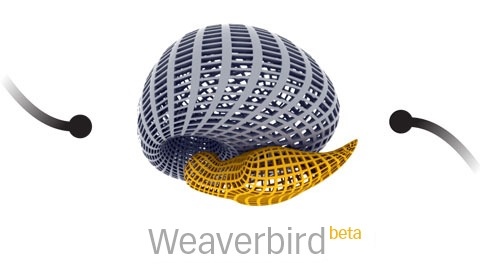

- #WEAVERBIRD GRASSHOPPER RHINO 7 SOFTWARE#
- #WEAVERBIRD GRASSHOPPER RHINO 7 ISO#
- #WEAVERBIRD GRASSHOPPER RHINO 7 WINDOWS#
#WEAVERBIRD GRASSHOPPER RHINO 7 SOFTWARE#
& Detailing 6- Particles 7- Meshes 8- Art 9- Architecture 10- Kinetic 11- Python 12- Animation 13- Optimization 14- Linkage 15- Particle Simulation 16- Others 5-Example files (Plugin-Based) 1- Lunchbox 2- Parakeet 3- Weaverbird 4- Pufferfish 5- Mesh+ 6- Paneling Tools 7- Ladybug 8- Millipede 9- Dendro 10- Kangaroo 11- Stella3d 12- Anemone 13- Linketix 14- Grasshopper 2.Grasshopper is actually a programming language that runs in the 3D software Rhino. & Detailing(5 Hr 15 Min) 3- Advanced(19 Hr ) 1- Optimization(6 Hr 45 Min) 2- Kinetic & Kangaroo (5 Hr 30 Min) 3- Jewelry(2 Hr 30 Min) 4- Architecture(5 Hr 30 Min) 5- Python (50 Min) 4- Example files (Topic-Based) 1- Fractals 2- Mathematical 3- 2D Patterns 4- 3D Patterns 5- Fab. It basically connects the center of the edges to the center of the mesh faces!ġ- Basics (13 Hr 30 Min) 1- What is Grasshopper3d? (2 Hr) 2- Attractors (6 Hr) 3- Rails & Sections (3 Hr) 4- Data Management (2 Hr 30 Min) 2- Geometry(16 Hr 45 Min) 1- Voronoi & Voxel(1 Hr 50 Min) 2- Meshes(1 Hr 45 Min) 3- 2D Patterns(4 Hr) 4- 3D Patterns(2 Hr) 5- Mathematical(2 Hr 20 Min) 6- Fab.
#WEAVERBIRD GRASSHOPPER RHINO 7 WINDOWS#

Mesh frame: This tool will offset your mesh edges and give you borders (you can combine this with Mesh thicken!).By combining Weaverbird with Cocoon you can produce amazing mesh models. If you change the Length be sure to set the reset to true and again to false!įinally, we get to the Weaverbird core tools. At the end connect the output to the Params>Geometry>Plankton mesh and finally to a mesh object. Define a number for iterations (maybe 5 to 15) and give a Boolean toggle to the Reset. Give a number to the Length input which will define the length of the mesh edges. In the extract section use the naked boundary to extract the boundary of the mesh and give it to the MeshMachine’s Fix curves. Give your mesh to the Geometry input and go to the weaverbird menu. This tool will also refine your mesh after splitting or editing your main mesh. You can use the “List item” tool to extract the top mesh and work on it with Kangaroo and cocoon.Īfter extracting the upper part of the mesh you can head over to Kangaroo Physics menu >mesh and use the Mesh Machine tool. Simply right-click on your viewport title and choose the clipping plane and move it to see the results.Īfter refining the Mesh you can use the Mesh split tool and split your mesh with a box mesh for example. You can also have a part of your mesh by using the “Clipping plane”. Give a “Boolean toggle” to the Execute input and double click it to “True” so you can have the refined mesh!

The sample size can be a number smaller than the size we gave to the cocoon component so start with the same number and gradually decrease it! The tolerance can be like 0.1 or 0.01. The most important input is the SubD which can start from 1 but don’t increase it to something like 3 or 4 as it will subdivide the mesh and increase the mesh size.

You can simply give the same number (maybe something between 5 to 15) to the “Samples” “Laplacian smoothing” and “Valence passes” because it will slightly change your overall mesh. The last step is to use the Refine tool to make the mesh smoother. You can also give a Brep charge if you want to add a solid or a surface to your overall model. This will produce voxels around the curves and connect the points together. You can also add multiple curves and give them a curve charge and connect them to the charges input. The cell size is the size of the voxels and it’s better to start with a bigger number and slowly decrease it to find the perfect size! Give a “Boolean toggle” to the Execute input and double click it to “True” so you can have the mesh!
#WEAVERBIRD GRASSHOPPER RHINO 7 ISO#
The ISO is a number between 0 and 1 and a lower number will merge the point charges in a near distance compared to a higher ISO number. The charge strength is basically 1 or -1 and it defines if the charge is positive or negativeĪfter producing the point charge you can use the Cocoon component to model the main mesh. To produce the point charge you can simply give the points to the point input and define the radius by using a “Gene pool” Be sure to double-click the gene pool and set the number of sliders same as the points. After installing all the plugins you can go to the Cocoon menu and use the point charge tool to produce a point charge


 0 kommentar(er)
0 kommentar(er)
